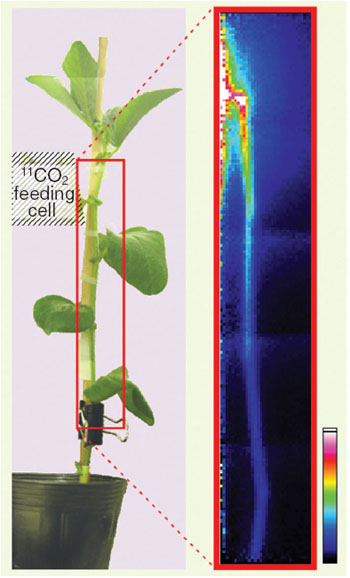Carbon dioxide ( CO2 ) is converted into sugars or other organic compounds by photoassimilation in plant leaves. They are distributed appropriately to various organs, such as roots or fruits, by phloem transport. How do plants manage to regulate this transportation process when they have neither a heart nor a nervous system?
We had previously developed the positron emitting tracer imaging system (PETIS) and successfully employed it to visualize transport of various radiolabeled compounds in intact plants. In particular, we had obtained movie images of photoassimilate transport in plant bodies by feeding a 11CO2 tracer into their leaves.
In the present study, we have developed a new analytical method to analyze the movie data captured by PETIS, wherein we can estimate the transport of radiotracers numerically. This enables to understand photoassimilate transport not just as a movie image, but in terms of quantitative dynamics. Using this method, we have tested the response of dynamics of phloem transport when an elevated level of CO2 has been fed into a leaf of a broad bean plant (Fig. 6-4). More specifically, optimal equations were determined which reproduce the transport dynamics captured by PETIS, then the distribution and flow speeds of photoassimilates in the stem were calculated with the equations. The results suggest that the flow speeds and the relative allocation of photoassimilates for roots increase with enriched CO2 applied to a leaf (Fig. 6-5). Such quantitative analyses help to make clear the power balance between consuming organs (roots, fruits and so on) and supplying organs (mature leaves) for plant nutrition, and may make an important contribution to agricultural sciences. |

